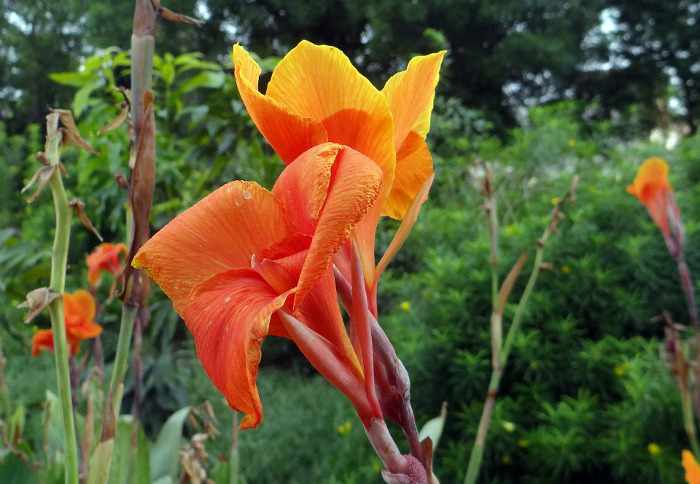Getting them going: From a seed to a plant

PHUKET: Recently, we considered propagation using cuttings taken from the parent plant (story here). A great method if it works. But some shrubs resolutely refuse to take root from pieces of stem immersed in potting mix. What then is the alternative?
Seeds are the obvious answer: in fact, most gardeners would opt for seeds as their first choice. Simplicity itself… Especially with annuals, biennials and perennials. Zinnias, poppies, nasturtiums and members of the asteraceae family come immediately to mind. Pod bearing shrubs such as jatrophas and trees such as cassias, flame trees, indeed any of the leguminous brigade will also grow from seed as will the yellow oleander (peruviana) and most of the commonly eaten fruit with seeds or stones – papayas, mangos, sapodillas, mangosteens, avocados, langsarts and the rest. In all these latter cases, the seeds are readily available if you are a fruit eater, right there on your plate.
But there are many plants that do not appear to produce visible seeds or, if they do, produce them so sparingly they are impossible to utilize. Moreover, packets of appropriate seeds are not always available, even in plant nurseries, and seed heads in the garden from annuals and perennials can easily be rotted by continuous rain.
A few principles. To germinate, all seeds need as priority number one, adequate moisture It also helps to have the right temperature range, and a loose-textured, friable soil that provides oxygen for the sprouting seed. Some seeds have a hard coat that does not allow water to penetrate – for example, canna lilies, lupins and robinias or locust trees. Before they can germinate, it is necessary to scarify the seed, to scratch away at the hard outer layer with sand paper or nick it with a knife.
It is always best to prepare a planting bed – shallow rows if you are growing vegetables – or, if you are using pots, to use a proprietary potting mix. Most plants get off to a better start if they are sown in containers and transplanted to garden beds later in the season. It is easier to provide pot plants with the temperatures and light they need and to protect them from birds and insects. Once these initial conditions are met, the radicle – the embryonic root – should emerge and begin to grow downwards. Afterwards, the first shoot appears above ground. Water sparingly with a rose or spray gun.
If seeding is a doddle, then layering assuredly is not. The technique aims to encourage new roots to form on branches still attached to the parent plant. The mother plant supplies the layer (the new plantlet) with water and nutrients during the rooting process. With ground layering, the technique works best with shrubs that have low-growing or trailing branches. Choose a young pliable shoot from low on the plant, cut a slit under the shoot where it will be buried, prepare the area with some compost, immerse the shoot and cover it with soil. Place a rock on top to hold the layer in place. Once roots have formed, cut the new growth free from the parent, dig it up and replant it in the garden.
Air layering or “marcotting” is based on the same principle and is used on higher branches. Make your incision in a vigorous shoot, encase the wound in damp moss or fiber, and cover the bundle with a plastic wrap, tied at both ends. Roots should appear after a few months. Then sever the rooted stem from the original plant and pot it on. I have used this procedure successfully with chalice vines and scheffleras, but it can also be employed with a range of hardwood shrubs including magnolias, most varieties of citrus, ficus elastica (rubber plant), witch hazels and rhododendrons. In the case of all these techniques, the application of a hormone rooting compound will assist the process of germination.
Tip of the Week: Stems and roots
Water, air and nutrients are all absorbed by roots. Root hairs increase the efficiency of roots by increasing the surface area exposed to trapped air and available water. Roots also anchor the plant in the soil. In shrubs, stems are usually woody at their center (which gives the plant extra strength and rigidity).
 Water, air and nutrients are all absorbed by roots. Photo: Frank Vincentz
Water, air and nutrients are all absorbed by roots. Photo: Frank VincentzThere are several layers in a mature plant’s stem. The core is woody, but next to this is a layer called the xylem which transports water and dissolved minerals from the roots, while the layer called phloem carries carbohydrates (food) down from the leaves to the rest of the plant. If you “girdle” a shrub or even a tree – i.e. ring it with a deep cut right through to the woody core – you will kill the plant, since it will be deprived of all living access to water and food.
If you have a question or a garden that you would like featured you can email me at: drpaccampbell@gmail.com. Further information about this gardening series and Patrick’s other work can be accessed at: patrickaccampbell.wordpress.com
— Patrick Campbell
Leave a Reply
You must be logged in to post a comment.








